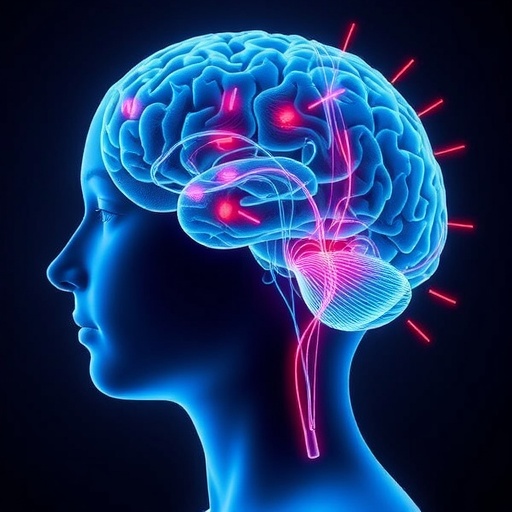In a groundbreaking advancement that could redefine treatment paradigms for patients with refractory epilepsy, researchers at the University of Pittsburgh and UPMC have unveiled a novel brain stimulation technique that tailors deep brain stimulation (DBS) according to the individual neural circuitry of each patient. This innovative approach, detailed in the latest issue of Nature Communications, introduces a precision-guided method for electrically modulating brain regions associated with seizure generation, promising to dramatically improve clinical outcomes for those unable to benefit from conventional medication or surgery.
Epilepsy, a chronic neurological disorder impacting over 50 million people globally, manifests through recurrent, unprovoked seizures. Approximately one-third of these patients exhibit drug-resistant epilepsy, where seizures persist despite optimal pharmacological intervention. Surgical resection remains a standard avenue for seizure control; however, many patients have epileptogenic zones intertwined with critical brain regions such as those governing speech, vision, or motor function, rendering surgical excision high-risk or contraindicated. Traditional DBS therapies, employing generalized targeting of the anterior nucleus of the thalamus, have yielded inconsistent therapeutic efficacy, leaving a substantial unmet need in personalized epilepsy care.
This new research, spearheaded by Arianna Damiani, M.Sc., a graduate researcher with the Rehab Neural Engineering Laboratories (RNEL) at Pitt, hypothesized that DBS effectiveness could be markedly enhanced by identifying and stimulating the specific thalamic subregions most intricately connected to each patient’s cortical seizure networks. To test this concept, the multidisciplinary team meticulously mapped the thalamocortical connectivity in 41 patients suffering from focal, drug-resistant epilepsy, integrating multimodal neuroimaging techniques with intracranial electrophysiological recordings. These detailed functional and anatomical analyses allowed the precise identification of thalamic loci which demonstrated the strongest synaptic and structural links to seizure foci in the cerebral cortex.
By deploying bespoke electrical stimulation protocols targeting these individualized thalamic zones, the study revealed a dramatic reduction in seizure frequency and intensity across the cohort. Patients implanted with long-term neuromodulation devices experienced an average seizure reduction of nearly 90%, with many achieving sustained seizure freedom for extended periods. This personalized stimulation strategy contrasts sharply with conventional DBS, underscoring the critical importance of understanding patient-specific brain network topology for therapeutic intervention.
The success of this approach rests on the convergence of cutting-edge imaging modalities, electrical brain recordings, and advanced computational modeling — an integrative methodology rarely combined at this scale in epilepsy research. UPMC Presbyterian’s epilepsy monitoring unit enabled the collection of high-resolution clinical data in a controlled environment, facilitating real-time assessment of seizure dynamics and stimulation effects. Jorge Gonzalez-Martinez, M.D., Ph.D., director of the epilepsy surgery service and co-author, emphasized that “the fusion of deep clinical expertise and innovative engineering has empowered the creation of hyper-personalized treatment paradigms, marking an inflection point in managing intractable epilepsy.”
The study offers crucial insights into the functional heterogeneity of the thalamus, a complex subcortical structure often regarded as a mere relay station. By recognizing the thalamus as a node with diverse and individualized connectivity patterns to cortical seizure zones, researchers have opened new vistas for precision neuromodulation. This notion holds transformative potential not only for epilepsy but also for other neurological disorders where aberrant network activity underlies pathology.
Previously, the Pitt/UPMC team demonstrated the therapeutic utility of thalamic targeting DBS in restoring motor function in patients with partial paralysis due to stroke and traumatic brain injury. This new work extends the paradigm, illustrating that judicious modulation of thalamocortical circuits can be calibrated to either potentiate or suppress neuronal activity depending on clinical objectives—highlighting the neurobiological versatility embedded within thalamic networks. Co-senior author Elvira Pirondini, Ph.D., noted that “understanding shared neural mechanisms across diseases equips us with the tools to drive forward neuromodulation therapies tailored not just to diseases, but to patient-specific brain physiology.”
The implications of personalized thalamic DBS extend beyond epilepsy treatment. The potential for adapting this approach to address psychiatric disorders such as severe depression or addiction is under active consideration, owing to common circuit motifs and network dysfunction identified within these conditions. This research heralds a future where brain stimulation devices are no longer generic therapies but instead become bespoke neurological prosthetics synchronized to the unique connectome of each individual patient.
This extensive investigation was supported by grants from the National Institutes of Health, reflecting a strong endorsement for research at the nexus of neuroengineering and clinical neuroscience. The interprofessional expertise spanning neurosurgery, neurology, biomedical engineering, and neuroscience was critical in operationalizing a research-to-clinic translational pipeline, promising a tangible impact on patient quality of life. The collaborative co-authors include Sirisha Nouduri, Jonathan C. Ho, M.D., Steve Salazar, Aude Jegou, Jiahao Jay Chen, Eliza Reedy, Naoki Ikegaya, and Thandar Aung, M.D., alongside interdisciplinary contributions from Johns Hopkins University’s Sridevi Sarma, Ph.D.
As this personalized DBS framework gains momentum, it beckons a paradigm shift in neurological therapies, emphasizing that effective treatment hinges on the individualized topography of the brain’s connective architecture. Future investigations will likely explore refining stimulation parameters, integrating real-time adaptive feedback systems, and broadening patient cohorts to validate and optimize this approach. Ultimately, this pioneering work charts a promising route to transforming refractory epilepsy management from approximate to precise, elevating patient-centered care to unprecedented heights.
Subject of Research: Personalized Deep Brain Stimulation for Drug-Resistant Epilepsy via Thalamocortical Connectivity Mapping
Article Title: Thalamocortical hodology to personalize electrical stimulation for focal epilepsy
News Publication Date: October 20, 2025
Web References:
- DOI Link
- UPMC Epilepsy Surgery Service
- University of Pittsburgh
References: National Institutes of Health grants 1R01NS122927-01A1 and 1R01NS131428-01A1
Image Credits: UPMC
Keywords: Epilepsy, Neurological disorders, Seizures, Neurosurgery, Deep brain stimulation, Rehabilitation centers, Personalized medicine




